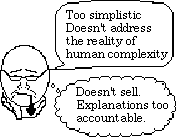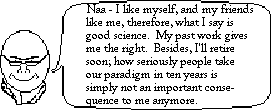
The Behavior Analyst, 1991, 14, 247, No. 2 (Fall)
A Catalyst for Discussion on Observables, Inference, and Behaviorism
William L. Palya
Jacksonville State University

- A key peck occurred.



- The key pecking behavior was performed.
- The pigeon emitted a response.
- Learning was demonstrated when the pigeon emitted the response.
- Learning was exhibited by the pigeon when it emitted the response.
- The pigeon learned the response.
- The pigeon learned to make the response.
- The pigeon learned that the response would be followed by food.
- The pigeon learned the rule that food follows the response.
- The pigeon learned to use rules in order to get the food.
- The pigeon used rules, drawn from its set of evolutionary-stable
strategies, to solve the problem preventing it from attaining the food it
needed.
- The pigeon needed food and, therefore, used its problem-solving strategies
in order to determine the correct rules required to satisfy its need, and
then emitted that operant.
- In order to reduce his drive for food, the pigeon used covert operants to
retrieve the correct rules and stimulus equivalents. After choosing the
goal with the best cost-benefit ratio, he then implemented his problem-solving
strategies by emitting the optimal overt operant.
- Because the criterion of uncertainity was exceeded, Charlie selected the
relevant cues and gained the reinforcing information. Expected
consequences were reinstated through covert operants. Using rules drawn from
the meta-rule store, he then decided to allocate behavior to the
alternatives of not responding and responding, so that they matched their
relative reinforcement densities corrected by the biasing factor
appropriate for that instant in time. Key pecking was used as an index of this
behavioral potentiality whenever pecking was correlated with the
quantitative model; otherwise, the key pecking behavior was considered to
be under the influence of a chaotic attractor, and an empirically determined
transformation was used.


The point is, In principle, a very old one: If each individual straw has
negligible weight, is it possible to create a load of straw which breaks a
camel's back? One could imagine a series of descriptions of some event, each
containing negligibly more inference. It's clear, that eventually the
descriptions would become unproductive. By what rule then should the series be
partitioned into appropriate and inappropriate, and at what point?
All Of the descriptions In the above list could have been operationally defined
as descriptions or behavior. As a result of course they would then be
behavioral descriptions by definition - In that case, however the modifier
"behavioral" would be tautological and would be meaningless. The list is, in
point of fact all conjecture, from less problematical to more problematical.
It is deliberately constructed of a series of negligible increases,
consecutively added to a description of a very simple event. It was created as
a catalyst for understanding the ramifications in or our descriptions.
- the description is of the behavior assumed to be the cause of the event
actually experienced by the observer (a counter increment).
- An implied actor is added to the inferred behavior. The focus is on
behavior, but there is a shift from the verb root "to be" (something exists) to
the verb root "to do" (an actor did something).
- the actor becomes explicit and the focus of the sentence shifts to the actor
away from behavior. the verb Implies that a behavior comes out of the actor.
- The focus of the sentence changes to learning, with a reference to the actor
and finally to the behavior. Learning is a synonym for behavior change.
- learning acquires a meaning which transcends behavior change.
- learning becomes a verb. the focus is on the actor. Behavior is what the
actor learns.
- an entity transcending the body or the pigeon, a homunculus learns "to
make". Not that the body comes "to do", nor that the response "is" but
rather an entity "makes. The root "learn" if it were operationally defined as
a behavior change would not draw -to make.-
- the homunculus becomes aware of a relationship.
- the homunculus learns an abstraction of a relationship
- a sentient homunculus uses abstractions

Date Last Reviewed : November 29, 2002




![]()



